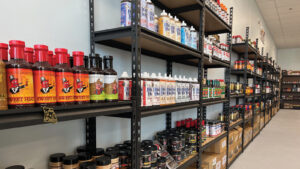
Office technology has evolved far beyond projectors in conference rooms, video displays and music systems.
The new frontier of office and retail space design is the integration of all electronic and technical systems. Adopting energy-efficient, “green” building standards and cost-effective measures to remotely monitor lighting, climate, shades, security and cameras is not just a trend. It’s increasingly becoming a necessity in commercial buildings.
When the CBT approached us to show how the commercial integration of audio and video could work, we all agreed that the historic Berry Building on Walnut and Orr streets would be a challenging (albeit hypothetical) case study.


The first floor of the newly renovated red-brick building is divided into several large and small spaces with various potential uses. PS: Gallery, which plans to move into the front corner, and the other future tenants will have different occupancy times and needs.
Audio/video
For their audio and video needs, tenants might want to share sources such as satellite music or digital cable in their various spaces, or they might have a shared conference area with a projector, screen and touch screens to control the system.
To allow users simple control over complex audio and video equipment, we could conveniently house all electronics in a mechanical closet, and they could control the functions with a smartphone or a tablet computer or from a wall-mounted screen in their offices.
Business operators in each office or retail space could set their own ambience with a high-quality audio and video system and create a comfortable atmosphere for their clients and customers. With multiple users, however, we need to ensure that there is a control system that is simple to use.
An iPhone, iPad or touch screen is an intuitive control interface. It allows any manager or employee to simply press one button to start a PowerPoint, for example, rather than fumble with a variety of remotes and cables to start an important presentation. A single button press can open drapes, drop a screen down from the ceiling and start the presentation.


Lighting
In a retail space or art gallery, lighting is important. More commercial clients are incorporating dynamic lighting scenes in their buildings.
From an elegant keypad or touch screen, a single button press can highlight art or architectural features by dimming different lights simultaneously and creating a warm environment in an art gallery.
Lighting control in a restaurant can make it simple to create an inviting mood for happy hour or the perfect lighting for an evening reception. These preset scenes ensure that the lighting is perfect every time. In a restaurant, bar or retail space with many users, this eliminates garish and harsh lighting. In addition, these scenes can automatically be adjusted based on time and do so subtly over a few minutes. Although each tenant in the Berry Building could independently create dynamic lighting scenes and simply access them over keypads, touch screens or even iPhones, the building owner could have all lights automatically turn off at a certain time of night. Security lighting could then activate automatically to create a safe and secure building environment without wasting energy by lighting empty rooms overnight.
Shade control
At the Berry Building, shades along the front south-facing windows would allow for privacy and climate comfort. With an easy-to-use control system, those shades could automatically open or close each day at set times.
The ability to open and close shades on windows, particularly tall ones, with a remote control device gives business owners complete control over the shading and allows them to adjust them for our warm Missouri afternoons. It also gives a uniform and attractive look across the front of a building, with all shades at even levels.
Climate control
This is, pardon the pun, a very hot topic in commercial building design right now. Business owners are continually looking at ways to cut overhead and expenses. Reducing heating and cooling costs is a crucial component of this goal.
In the Berry Building, there would likely be multiple HVAC units and zones. Allowing each tenant to independently control heating and cooling levels during the day from a wall-mounted touch screen, computer or iPhone is convenient for them.
But a control system can take this one step further. Integrating climate control with occupancy-based security sensors means that the thermostats can automatically adjust to an energy-savings level when the last employee leaves and arms the alarm. A building owner can use this type of system to make sure that all thermostats automatically adjust back to an energy level when the building is empty.
Security
The market for intelligent security systems and surveillance systems is growing exponentially.
At the Berry Building, cameras at the various entry and exit points, including the frontage on Walnut and the back alley areas, would be an excellent security measure. Not only can these cameras be viewed in offices on site but also remotely by any of the tenants or the building owner. In addition, these cameras can be viewed on an iPhone or other smartphone.
Intelligent security systems can allow any tenants to check the status of their alarm from their phone or home computer and make sure it is armed in the evening when they are not there. A user log built into the system can allow supervisors to see who has armed or disarmed the security alarm directly from the keypad. Water sensors could allow the owner to be alerted if there is flooding within the building.
Overall, this type of integration, advantageous in our fast-paced world, allows for individual control within the separate spaces in the Berry Building, as well as remote monitoring by the building owner or manager.
With one press of a button or icon, the perfect dining experience can be enhanced with lighting and sound and then recreated every night with ease; art and architecture can be highlighted with dynamic lighting scenes; and business owners can manage their spaces quickly and reliably from south of town — or from South America, for that matter. v
Bridgid Miller co-founded August Systems 14 years ago. She sold the home electronics company to Marathon Building Environments last month, but she is still managing the business, which is expanding into commercial applications.









